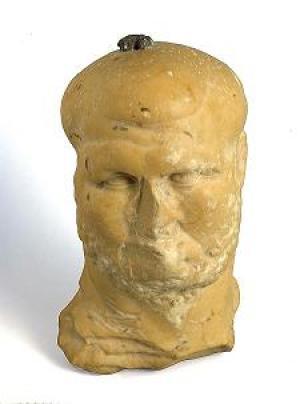1,800-year-old marble statue
A marble statue shows a miniaturized head of a bearded man discovered during an excavation by an Israeli ancient monk expert in David's Givati parking lot, National Park. Jerusalem family. The statue is used as a weight with a balance.
According to Dr. Doron Ben-Ami and Yana Tchekhanovets, the director of the excavation on behalf of the Israeli ancient monument team, said: 'The part perfecting the sixteen statues is truly amazing, while still respecting those Smallest details. The short curly whiskers, as well as the first position slightly tilted to the right, are indications of Greek influence and suggest that it dates back to the Emperor Hadrian's time. This is the time when Roman sculpture art reached its peak. The pale yellow shade of marble refers to the eastern origin of the raw material from which the picture is carved, possibly from Asia Minor, but this problem still needs to be checked. '
The artistic theme is shown on the statue, such as short hairstyles, raised lobes and curves of the ears, as well as almond-shaped eyes that show that the object may be a portrait of an athlete, Can be a boxer. Boxing is one of the most popular sports fields in Roman culture and more than a Roman author mentions the need for Roman communities to say them, and high-class actors in particular, for matches boxing.In addition to the prestige and considerable amount of money that winners receive, they also receive the emperor's affection, the famous case is Melancomas, Titus's favorite gladiator.
 Statue image. (Photo: Clara Amit)
Statue image. (Photo: Clara Amit)
Dr. Ben-Ami and Tchekhanovets explained: 'In our understanding, so far no similar artifacts are made of marble (or any kind of stone) with such images found. anywhere else in the country. It seems that the statue we found is unique. A number of similar artifacts are made from cast bronze found in other places in the country, and they were discovered in large numbers elsewhere in the Roman Empire and most are dated to the century. 3rd CE. The bronze portrait of a gladiator is currently on display at the Berlin State Museum ('Gladiator') almost identical to the statue from the city of David '.
According to the researchers, the two pores that are drilled on the nape and contained in the metal are added to show that the statue is a hanging weight used in balancing scales, a characteristic of the Roman period.The bronze miniatures of athletes, philosophers and forest gods are the most popular hanging weights used in areas under the rule of the Roman Empire - from Pompeii to Sepphoris.
How did the Roman marble statue enter the city of David?
We can predict that this marble weight belongs to a merchant family from somewhere in the eastern Roman Empire. As a worthwhile object, this weight was transmitted from generation to generation in the family until about the 14th century CE when an unlucky merchant was in a public building currently excavated at the site. Givati parking in David City. A strong tremor completely destroyed the building. When the building was excavated, the marble statue was discovered in the rubble, a silent proof of the tragedy that occurred with this impressive structure.
Not long ago, one of the largest and most impressive coin treasures found in Jerusalem was also at this location. It consists of 264 gold coins discovered at the same time with a golden earrings, pearl inlaid expensive and very well preserved.
- Detecting the monk statue in rare marble
- Thousand-year sphinx statue in the tomb of Tang Dynasty
- Discovered a 2,000-year-old metal god statue of Celts
- The 23,000-year-old love idol statue has a beautiful beauty
- Digging soil to detect a 1000 year old god statue
- China: Excavating the 1500-year-old Bodhisattva Buddha statue
- The 600-year-old Buddha statue floats on the lake causing fever
- The 3,000-year-old statue in Turkey reflects feminism
- Found 1,900 year old eagle statue between London
- Discovered two female statues in the Amphipolis tomb area
- Detecting debris from a 40-thousand-year-old mammoth ivory statue
- Discovered an ancient Buddha image of 2000 years of rare and rare blush
 Discovered an ancient centipede fossil 99 million years old
Discovered an ancient centipede fossil 99 million years old Discovered bat-like dinosaurs in China
Discovered bat-like dinosaurs in China Discovered a 200-year-old bronze cannon of the coast
Discovered a 200-year-old bronze cannon of the coast Discover 305 million-year-old spider fossils
Discover 305 million-year-old spider fossils